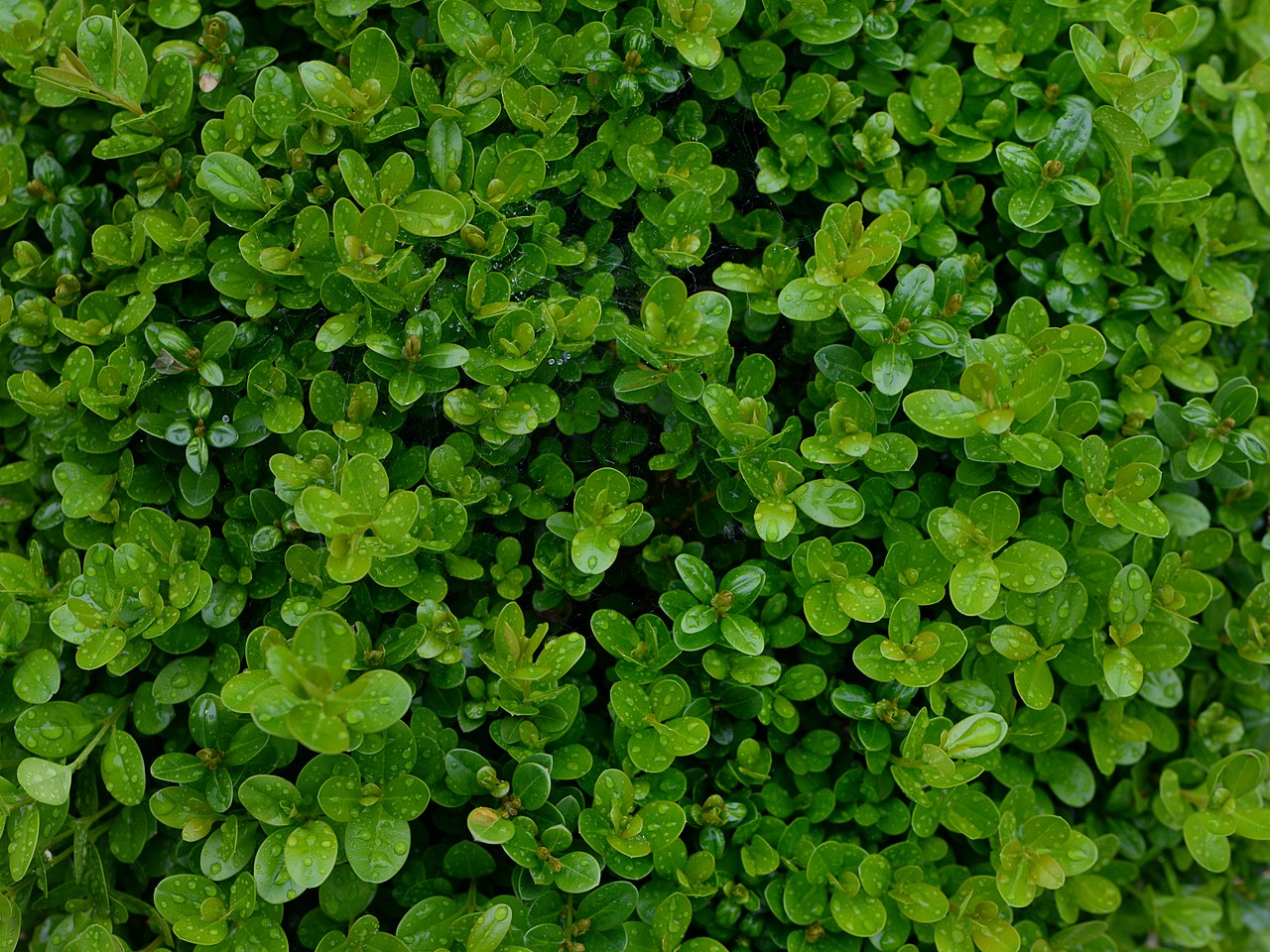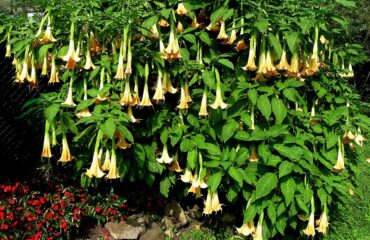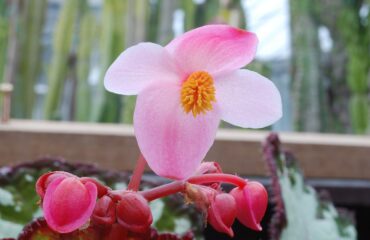Buxus sempervirens, commonly known as Common Boxwood, is a versatile evergreen shrub native to Europe, northern Africa, and western Asia. It is highly valued for its dense, compact foliage and its ability to be shaped into topiaries, hedges, and formal garden structures. The leaves are small, oval, and glossy green, with a subtle fragrance when crushed. Boxwood is a slow-growing plant, typically reaching heights of 2-12 feet (0.6-3.6 meters) and spreads of 2-8 feet (0.6-2.4 meters), depending on the variety and growing conditions. It is widely used in formal gardens, as borders, or in container plantings.
Preferred Growing Conditions:
- Soil Type: Prefers well-drained, slightly acidic to neutral soil; thrives in loamy or sandy soils enriched with organic matter.
- Sunlight: Grows best in partial shade to full sun; can tolerate full sun in cooler climates but may need some afternoon shade in hotter regions.
- Temperature: Hardy in USDA zones 5-9; prefers temperate climates and can tolerate light frost and cold winters.
- Water Needs: Moderate; requires regular watering during dry periods, especially when young, but is relatively drought-tolerant once established.
Buxus Sempervirens (Common Boxwood) Propagation Methods:
1. Stem Cuttings:
Stem cuttings are the most common and effective method for propagating Buxus sempervirens, allowing for the production of new plants that retain the characteristics of the parent.
- Types of Cuttings:
- Use semi-hardwood cuttings taken in late summer to early autumn when the plant is not actively growing.
- Preparation:
- Select healthy, non-flowering shoots and cut 4-6 inch sections just below a leaf node.
- Remove the lower leaves, leaving only the top few pairs of leaves on the cutting.
- Optionally, dip the cut end in rooting hormone to encourage faster rooting.
- Planting:
- Insert the cuttings into a well-draining potting mix, such as a blend of peat and perlite or a commercial rooting mix.
- Water lightly to settle the soil and place the pot in a bright, indirect light location.
- Cover the pot with a plastic bag or place in a propagation tray with a clear lid to maintain high humidity.
- Rooting:
- Roots should begin to form within 6-8 weeks.
- Once roots are established and new growth appears, gradually acclimate the cuttings to lower humidity.
- Transplant the rooted cuttings into individual pots or directly into the garden.
2. Seed Propagation:
Growing Buxus sempervirens from seeds is less common and can be more challenging due to the slow germination and growth rate. However, it is an option for those interested in exploring the natural variation of these plants.
- Seed Collection and Preparation:
- Collect seeds from mature fruit capsules in late summer to early autumn once they have dried and turned brown.
- Clean and dry the seeds for a few days before planting or store them in a cool, dry place until ready to plant.
- Seeds may benefit from stratification. Place seeds in a moist medium (such as sand or peat moss) and refrigerate at around 35-40°F (1.5-4°C) for 1-2 months to break dormancy.
- Sowing Techniques:
- Sow seeds in seed trays or small pots filled with a light, well-draining seed-starting mix.
- Sow the seeds on the surface and cover lightly with a thin layer of soil or sand.
- Keep the soil consistently moist but not waterlogged.
- Place the trays in a bright location with temperatures around 65-75°F (18-24°C).
- Germination Requirements:
- Seeds typically germinate within 3-6 weeks under optimal conditions, but may take longer.
- Once seedlings emerge, provide bright, indirect light and maintain consistent moisture.
- When seedlings have developed several true leaves and are sturdy enough to handle, transplant them into individual pots.
3. Division:
Division is a method used primarily for mature, well-established Buxus sempervirens plants that have formed dense clumps. This method helps rejuvenate the parent plant and produce new plants with identical characteristics.
- Timing:
- The best time for division is in early spring before new growth begins or in early autumn after the active growing season.
- Method:
- Carefully remove the plant from its pot or dig up the clump from the garden, taking care not to damage the roots.
- Use a sharp knife or garden spade to divide the root ball into smaller sections, ensuring each division has several shoots and a portion of the root system.
- Remove any dead or damaged roots and foliage.
- Replanting:
- Replant the divisions immediately in prepared pots filled with a well-draining potting mix or directly into the garden.
- Plant at the same depth as the original clump, spacing divisions to allow room for growth.
- Water thoroughly to settle the soil around the roots.
- Care After Division:
- Keep the newly planted divisions well-watered as they establish.
- Place the pots in a bright, indirect light location or a partially shaded spot in the garden.
- Protect from strong drafts and sudden temperature changes during the initial recovery period to prevent stress.
4. Layering:
Layering can be used to propagate Buxus sempervirens, particularly for branches that can be bent to the ground and encouraged to root while still attached to the parent plant.
- Timing:
- Best done in spring or early summer when the plant is actively growing.
- Method:
- Select a healthy, flexible branch near the base of the plant.
- Bend the branch down to the ground and make a shallow cut or wound on the underside where it will be buried.
- Apply rooting hormone to the wound to encourage rooting.
- Bury the wounded section of the branch in the soil, securing it with a U-shaped pin or a rock.
- Keep the soil moist and leave the branch in place for several months to allow roots to develop.
- Rooting and Separation:
- Once a good root system has developed, cut the branch from the parent plant and carefully remove the rooted section.
- Plant the rooted section in a pot or directly in the garden, ensuring the roots are well-covered and watered thoroughly.
Care for Newly Propagated Plants:
- Place new plants in a location with partial shade to full sun, adjusting the light exposure based on your climate and the plant’s needs.
- Water regularly to keep the soil consistently moist but not waterlogged.
- Apply a balanced, slow-release fertilizer every 4-6 weeks during the growing season to promote healthy growth and development.
- Protect from strong drafts and sudden temperature changes to prevent stress.
- Mulch around the base to retain moisture and suppress weeds, especially for garden-planted Boxwood.
Common Challenges and Solutions:
- Boxwood Blight: Monitor for signs of this fungal disease, including leaf spots, defoliation, and stem lesions. Remove and destroy affected plant parts, improve air circulation, and apply fungicides as needed.
- Pests: Watch for pests like boxwood leafminer, mites, and aphids. Treat infestations with insecticidal soap or neem oil.
- Leaf Browning: This can indicate water stress, whether from overwatering, underwatering, or root damage. Adjust care and ensure proper watering practices.
Additional Tips:
- Prune regularly to maintain the desired shape and size and to encourage denser growth.
- Avoid heavy pruning in late summer or autumn, as this can stimulate new growth that is susceptible to winter damage.
- Use pots with drainage holes to prevent water accumulation and root rot when growing Boxwood in containers.
- Boxwood is excellent for formal gardens, topiaries, and as a hedge plant due to its dense foliage and slow growth.
Conclusion:
Propagating Buxus sempervirens provides a rewarding opportunity to grow these versatile and elegant shrubs in your garden or as ornamental plants. Whether you choose to start from stem cuttings, use seeds, divide larger plants, or try layering, with proper care and attention, Boxwood will thrive and bring its classic beauty and structure to your landscape.
Share this article



